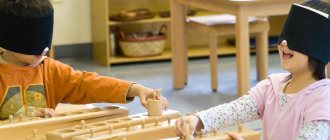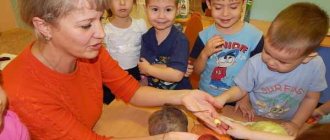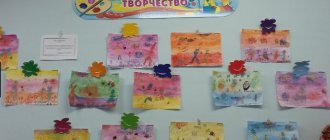Leisure and entertainment in preschool educational institutions
The teacher should remember that leisure is a compensatory type of children’s activity; entertainment and cultural recreation are contrasted with routine activities. Therefore, free time activities have a strong emotional focus; children should be in a good mood.
Discussion of heroes and plots of Russian folk tales stimulates children's interest in creative activities
Motivating start to a lesson on cultural and leisure activities
Classes within the framework of cultural and leisure activities contain a mandatory structural component - a motivating beginning. To attract children's interest in the upcoming event and activate their curiosity, various motivation techniques are used:
- studying visual material: looking at thematic posters,
- pictures,
- reproductions,
- illustrations in books,
- layouts,
- mini-exhibitions in the corner of knowledge,
- visiting a group by a fairy-tale character,
Since the leading activity of preschoolers is play, children are happy to engage in play situations and participate in a variety of activities.
Table: examples of motivating beginnings of classes for different topics
| Lesson topic | Option for a motivating start |
| “Journey to the Land of Fairy Tales” (leisure-entertainment) |
|
| “Visiting a Russian folk tale” (theatrical leisure) |
|
| "Australia! Australia! Beautiful continent" (sports leisure) | Studying visual material and conducting an educational conversation. The children are invited to study a map of Australia, which shows representatives of flora and fauna, and answer the questions:
The teacher offers to get to know the peculiarities of the mainland and its inhabitants better by participating in thematic outdoor games. |
| “Joyful colors of winter” (musical leisure) |
|
Event Planning
Conducting classes within the framework of cultural and leisure activities is allocated free time in the educational process in the morning and evening. Leisure activities should be systematic and thoughtful, carried out according to calendar and thematic planning. In classes, the principle of frequent change of types of children's activities is observed (observation, conversation, physical education, creative, speech, motor activity).
The frequency of cultural and leisure activities is determined by the age and individual characteristics of the students, the scope of the assigned tasks and the breadth of the content of the holiday or fun. Sports and creative leisure activities are held 1-2 times a month, physical education, musical, literary, theatrical events and concerts - 2-3 times a year.
It is recommended to hold major holidays several times during the school year.
A special place in planning leisure and entertainment in kindergarten is occupied by folk and church holidays, street celebrations and rituals associated with the folk calendar: harvest festival, Christmas Eve, Christmas festivities, Maslenitsa fun, farewell to winter, Palm Sunday and Easter, Honey and Apple Savior . Getting to know traditions and ancient customs introduces children to the culture of their native country and fosters a reverent attitude towards preserving history.
Familiarization with folk traditions is an important component of the educational process in preschool educational institutions.
Long-term planning involves holding events together with a music director, a physical education teacher, and additional education teachers (heads of theater and fine arts clubs, dance studios, sports sections). During the school year, consultations are held for parents, at which the tasks of organizing leisure and entertainment in kindergarten are indicated, a plan for future cultural events is outlined, parental initiative in preparing and participating in events is encouraged, and a list of recommendations is given for organizing home leisure (reading, drawing, experimenting) , educational walks). Thus, parents are given the opportunity to collaborate with the teaching staff of the preschool educational institution and become equal participants in the educational process.
Fun activities that involve children with moms and dads have a therapeutic effect on family relationships
Table: card index of topics of cultural events
| Thematic focus of cultural and leisure activities | Leisure | Holidays |
| Sports |
|
|
| Creative (musical, theatrical) |
|
|
| Literary |
|
|
| Cognitive |
|
|
| Social |
|
|
| Folk, Christian |
|
|
Table: example of a summary of cultural and leisure activities in the preparatory group
| Author | Zhilina E. V., MDOU D/s “Vasilyok” r. Mullovka village, Ulyanovsk region. |
| Name | "Journey Through Fairy Tales" |
| Program content |
|
| Preliminary work |
|
| Material |
|
| Progress of the lesson | The melody “Come to visit us” from the fairy tale “There, on unknown paths” sounds. Presenter: Today, guys, I want to invite you to travel to the amazing land of fairy tales. It is generously inhabited by various good and evil heroes: gnomes and trolls, sorcerers and goblins, Baba Yaga and Kashchei the Immortal, Ivan Tsarevich and Helen the Beautiful. Getting there is not difficult, you just need to close your eyes for a few moments and imagine that we are flying on a magic carpet, across seas and oceans, forests and steppes. Here it goes lower and lower, and before us is the first fabulous stop. Here is someone's letter, and you will find out who sent it by guessing the riddle.
Right. Now let’s find out what the gnome wants. (Reads the task: guess fairy tales from illustrations). You have to learn fairy tales. I will show you illustrations for famous fairy tales, and you must accurately say the name of the fairy tale and its main characters. (Shows 6–7 illustrations.) Well done! Complete the task and receive a magic petal. (Gives the children a red petal). Well, let's fly on. The journey continues. (Music sounds). Here comes the next stop. Guess who it is:
The station is called “Guess” from Little Red Riding Hood. I will read you excerpts from fairy tales you know, and you must guess their names.
The presenter praises the children and gives them another petal. The journey continues. (Music sounds). Presenter: And here is the next station: tricky riddles. Guess it and answer quickly! Puzzles:
Presenter: I see, you really know a lot about fairy tales. Well done! Now let's go to the next station. (Music sounds). Competition “Say the Word.” Presenter: Many fairy tale heroes have unusual and very interesting names, let's remember them. I tell you the beginning of the name, and you will try to continue it. Two teams participate in this competition; the one who answers faster wins this competition. Begin!
Presenter: We completed the task, let's move on. (Music sounds). And here a magic chest awaits us, let's see what's in it. (In the chest there are masks for playing out the fairy tale “Teremok”). Now let's say the magic words:
(The song “Fairy tales walk around the world” by M. Plyatskovsky is played). Presenter: Here we are again in our kindergarten. And from the petals we got a magical flower. Our journey is over. Did you like it? It was interesting? Funny? (Children's answers). |
Temporary lesson plan for cultural and leisure activities
The duration of leisure and entertainment depends on the age and individual characteristics of preschoolers.
Leisure duration:
- in junior and middle groups - 25–30 minutes,
- in senior and preparatory groups - 45–50 minutes.
Duration of holidays:
- in the first junior group - 20–30 minutes,
- in the second younger group - 30–35 minutes,
- in the middle group - 45–50 minutes,
- in the senior group - 60 minutes,
- in the preparatory group - up to 1 hour 30 minutes.
The duration of the festive event depends on the age and individual characteristics of the pupils
Duration of street fun and folk festivals:
- in junior and middle groups - no more than 1 hour,
- in senior and preparatory groups - up to 1 hour 30 minutes.
Let's consider the approximate duration of the structural components of specific cultural and leisure activities.
Folklore and physical education leisure time “Time for business, time for fun” in the senior group
- Organizational moment - 2 minutes.
- Surprise moment - 5 minutes.
- Outdoor game “Horse” - 7 minutes.
- Game exercises “Guess it” - 10 minutes.
- Outdoor game “Cat and Birds” - 6 minutes.
- Round dance “Sun” - 4 minutes.
- Sports game “Catch the ball” - 8 minutes.
- Summing up your leisure time - 3 minutes.
Musical celebration for Defender of the Fatherland Day in the preparatory group
- Greeting guests of the holiday - 2 minutes.
- Performance of the song “Defenders of the Fatherland” - 3 minutes.
- Reading poems - 5 minutes.
- Performance of the song “We will serve in the army” - 3 minutes.
- Intellectual warm-up for the boys' team and the dads' team - 8 minutes.
- Dance “Sailors and Sailors” - 4 minutes.
- Competition for adults and children “Strong Men” - 6 minutes.
- Reading poems - 5 minutes.
- Performance of the song “Our Dads” - 3 minutes.
- Game for children and guests “Sandwiches” - 7 minutes.
- Poetic congratulations to the boys from the girls of the group - 5 minutes.
- Game "Obstacle" - 7 minutes.
- Music competition - 8 minutes.
- Musical game “Girls hee hee, boys ha ha” - 7 minutes.
- Dance "Stars" - 3 minutes.
- Congratulatory words from the host of the holiday, presentation of cards and gifts - 7 minutes.
Leisure activities with the participation of parents “Maslenitsa” in the middle group
- Organizational moment - 3 minutes.
- Excursion into the past (use of ICT: educational slide show) - 10 minutes.
- “Know-It-All” competition – 5 minutes.
- “Guess it” competition – 5 minutes.
- Competition "Folk Games" - 5 minutes.
- Steeplechase competition - 4 minutes.
- Competition "Fist Fights" - 4 minutes.
- Music competition - 8 minutes.
- Summing up the results of the competition, invitation to tea with pancakes - 4 minutes.
Examples of organizing leisure and entertainment in kindergarten
The options presented below for organizing cultural and leisure activities for preschoolers will allow teachers to learn from the successful experience of their colleagues, and parents of students to prepare for the planned events.
Video: music day in kindergarten
Video: sports festival in kindergarten
Video: musical and theatrical leisure “Ecological fairy tale”
Video: fun on a walk dedicated to the celebration of Maslenitsa
Video: Quiz “Fun Math”
Video: creative leisure “These days the glory will not be silent”
Video: literary festival “Days Fly”
Preparing and conducting collective leisure activities in kindergarten creates a sense of group cohesion. By decorating the decorations for the holiday, distributing roles in a dramatization game, mastering the skill of choral singing, participating in team competitions and quizzes, preschoolers interact positively with each other. In joint activities, group traditions are born and the emotional atmosphere improves. Participation in collective events fosters an active and morally oriented personality in every child.


